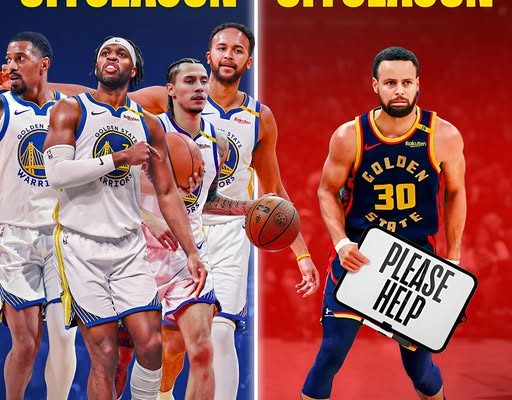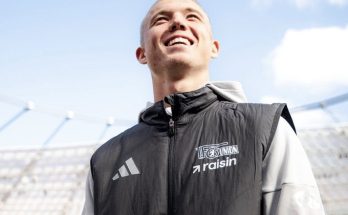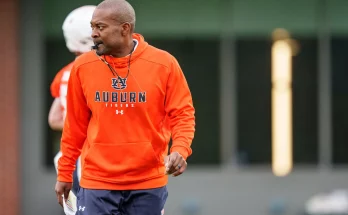Golden State Warriors Face Familiar Offseason Frustrations as Questions Loom Over Jonathan Kuminga and Future of Title Contention
For the second straight summer, the Golden State Warriors have found themselves in a frustratingly familiar place: stuck in between eras, tiptoeing around bold decisions, and seemingly unwilling—or perhaps unable—to swing big in a league that increasingly rewards aggression and risk. Despite murmurs of major moves and a generational talent still on their roster in Stephen Curry, the 2025 offseason has mirrored the one before it—quiet, calculated, and, for many, underwhelming.
Looking back, the 2024 offseason followed a similar script. The front office made modest upgrades—pieces that added some depth, a few rotational shooters, and potential on the fringes. But none of those additions significantly moved the needle. The team stayed afloat in a competitive Western Conference, but by the time the playoffs came around, it was clear: the roster, as constructed, lacked the firepower and consistency needed to challenge the top-tier contenders.
It wasn’t until the trade deadline that the Warriors finally pulled the trigger on a headline-grabbing move, acquiring Jimmy Butler in a move that drew national attention. On paper, the trade was a statement—an acknowledgment that Curry’s window won’t stay open forever and that the front office was ready to support him with another hard-nosed, battle-tested star. But in practice, the move came too late. The chemistry wasn’t fully developed, the team still lacked interior presence and reliable bench production, and ultimately, the postseason exit came earlier than hoped. Once again, Curry poured everything into trying to will the Warriors to greatness. Once again, it wasn’t enough.
Now, the 2025 offseason has unfolded with a strange sense of déjà vu. Golden State added shooting. They added depth. They invested in youth. But they did not land a transformative piece. There was no blockbuster acquisition, no franchise-altering trade, and no bold shift in direction. Instead, the biggest storyline circling Chase Center this summer hasn’t been who’s coming in—it’s been whether Jonathan Kuminga is staying or leaving.
Kuminga, now several years into his NBA career, has become the center of Golden State’s internal tug-of-war. Once considered a project with massive upside, he’s blossomed into a promising player with athleticism, defensive potential, and flashes of offensive polish. But inconsistency and questions about fit have persisted. Can he be a reliable playoff contributor? Can he be trusted in high-stakes situations when the game slows down and experience matters most? The Warriors haven’t fully committed to him, and that uncertainty has hovered like a cloud over the team’s decision-making this summer.
Instead of using Kuminga as a trade chip to acquire another All-Star or proven veteran, the Warriors have hesitated. Whether it’s due to believing in his potential or lacking the right market opportunity, the indecision has defined their offseason. That indecision, in turn, has distracted from larger, more pressing goals: building a roster capable of contending now, in the twilight of Stephen Curry’s historic career.
The problem with betting on youth is that development takes time—time the Warriors don’t have. Curry, now approaching the final stretch of his career, is still one of the best players in the league. His shooting remains transcendent, his leadership invaluable, and his will to win undiminished. But even he cannot overcome a roster that isn’t fully optimized for postseason success. Draymond Green continues to anchor the defense and provide emotional intensity, but his ability to stay on the floor consistently has become a growing concern. Jimmy Butler, tough and tested, is a leader in his own right, but injuries and age are starting to cast a shadow over his production. The trio can only carry the team so far without the right supporting cast and system around them.
It’s this reality that has made the Warriors’ quiet offseason so disheartening to many within the fanbase and around the league. Golden State is not in a rebuild. Nor are they in a full “win now” mode. They’re in limbo—a place where half-measures and hesitant moves threaten to waste what little time remains in Curry’s illustrious career. There is a sense of urgency that seems to exist everywhere except the front office.
Warriors fans, used to championship banners and dynastic success, are now faced with the uneasy possibility that the team is content being competitive rather than dominant. That they are choosing to preserve assets and flexibility over going all-in while their window is still cracked open. That they are, in effect, letting an opportunity slip away.
The internal focus on Kuminga has been both a distraction and a symbol of a larger issue. The franchise seems split between developing its future and honoring its present. It’s not that Kuminga isn’t talented—he is. But in a league where superteams are rising and power balances shift rapidly, patience can be costly. Trading youth for veteran help always carries risk, but so does doing nothing. And the Warriors’ inaction may say more than any words coming from press conferences or leaked reports.
Around the league, other teams have taken swings. The Celtics doubled down. The Thunder are rising with bold moves. The Nuggets, still powered by Jokic, remain a threat. The Mavericks, Suns, Clippers—all made offseason choices aimed at immediate success. The Warriors, by contrast, have made moves that suggest they are playing the long game. But for a team with a generational shooter still performing at elite levels, the long game may not be the right game.
The spotlight now turns to the regular season. Can Curry, Green, and Butler lead the Warriors to a top-four seed? Will Kuminga prove his worth and quiet the trade rumors? Will the new role players step up when it matters? These are the questions that will define the upcoming year. But they’re questions that could’ve had different answers if the front office had chosen to be more aggressive, more daring, and more decisive.
In the NBA, windows close faster than they open. For every dynasty, there’s a final chapter. And for Stephen Curry, the clock is ticking louder than ever. He deserves a team that reflects his greatness—one built to compete at the highest level, not just survive. Anything less feels like a disservice to the legacy he’s built and the magic he continues to deliver night after night.
This offseason has reinforced that the Warriors are at a crossroads. They can continue straddling the line between contention and transition, or they can fully commit to giving Curry one last, best chance at a ring. Right now, the signs suggest hesitation. But the season will be the ultimate test.
Golden State has never been afraid of pressure before. Now, as another campaign begins, they must decide if they’re content with nostalgia or hungry for another title run. Because when the final buzzer sounds on Curry’s career, the only question that will matter is whether they did everything they could to make his last chapter a winning one.



